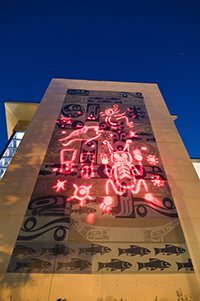This mural by Marianne Nicolson is located on the outside wall of the Municipal Hall at 1229 Esquimalt Road.
 The artist describes the work:
The artist describes the work:
The title refers to the light images that appear at night. The images are taken from pictographs which appear along the coast. These paintings on rock, usually executed in red pigment, are among the earliest forms of art created. I wanted to draw a line between contemporary native art and its origins. Contemporary Northwest Coast art has become very stylized and recognized as a Northwest Coast iconography.
I thought the juxtapositioning of the pole across the way was interesting. I created the painted work as a contemporary rendering of Northwest Coast art. The pictograph images that you can only see night are a subliminal attempt to draw attention to the origins of this art production using the contemporary medium of light. The pictographs marked both significant events and places. I suppose in my own way I am attempting to mark a significant point in Northwest Coast art production.
The mural consists of modular images in natural, stone-coloured hues of green, blue and grey. The images depict aboriginal style iconography and references to the natural environment in Esquimalt. Trees, water, fish, plants, birds and faces are depicted as well as a traditional canoe and sailing ship. The rounded images are of baby whales. Two Ravens are shown, one ascends while the other descends; their heads look like hands.
The red foreground images are styled from petroglyphs and pictographs on the coast. These images, which are projected onto the painted surface at night, refer to the more ancient history of the region. These images are a Spirit Figure (a human with two horns on his head signifying supernatural powers); Whales; Small Creatures; Coppers and Stars. Conceptually the work refers to the history of the Esquimalt, Coastal Region of the Pacific Northwest both before and after the coming of the Spanish Explorers of fairly recent history.
